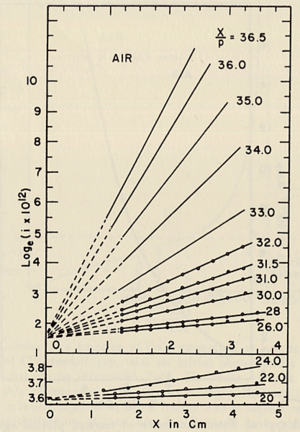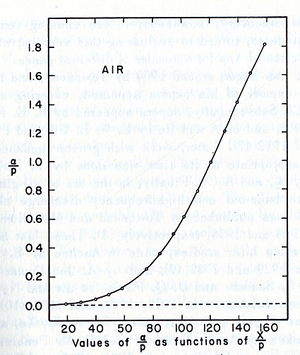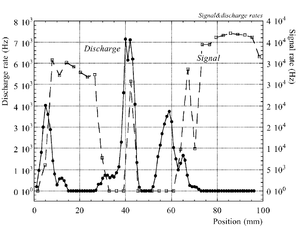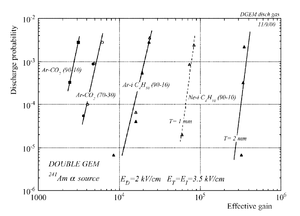Gaseous Medium Physical Concepts
Related Physical Concepts
The gaseous medium inside a detector's chamber contains different physical processes as a particle arrives the gas in the chamber. When the desired the particles penetrate the gaseous medium, they directly or indirectly (neutron fission) ionize the gas. If the event happened in the active detection area of the detector, a drift electric field guides the primary and secondary electrons toward the GEM preamplifiers, they are placed to have a separation distance within the maximum limit to not lose the electrons by diffusion, and to multiply the number of electrons to create an avalanche directed toward the read out plate which collects the electrons to appear as a negative pulse on the oscilloscope. Electron recombination, deattachment and capture take place in every stage in the electron trip before they reach the readout plate, especially in case of the gas' pressure is higher than the atmospheric pressure. Also, the preamplifiers may have discharge events on their surfaces that usually damage them.
The detector pulse is evaluated by a mathematical description to each physical process that occurs in any stage to count the number of the electrons' pulse. Measuring the output of helps in calculating the detector efficiency, dead time, gain, spatial resolution and robustness.
Ionization
Ionization is the liberation of an electron from the confines of a medium atoms or molecules. Also the minimum amount of energy required to liberate the electron is referred to as the ionization energy. When the ionizing particle get in the medium, it deposits its energy to free electrons, energy in excess of this ionization energy will appear in the form of kinetic energy carried by the free electrons. For instance, charged particles, like fission fragments, ionizes a gaseous medium and free electrons with kinetic energy that depends on the fragment energy deposition remained after ionization.
The ionization process depends stochastically on the ionization cross section which is usually determined by the ionizing particle energy, and mass( heavy or light in case of fission fragments), but it is observed that the amount of energy needed to have an ionization event in a gas is the same on average <ref name="Veenhof"> R. Veenhof, Internal Note/TPC, ALICE-INT-2003-29 version 1.0, 2003</ref>, regardless of the incident particle type or energy as shown in the following table for argon gas.
| Type of particle and its energy | 9 keV x-rays | 10 keV electrons | 40 keV electrons | x-rays Ar-37(K-capture)(5-25 keV) + beta | alpha 7.68 MeV | 340 MeV protons |
| Energy per ion-electron pair (eV) | 27.9 1.5 | 27.3 | 25.4 | 27.0 0.5 | 26.25 | 25.5 |
Ionization in fission chambers
Ionization by fission fragment is not the only source for a electrons and it is not the only ionization process in fission chamber. These chambers basically contain a neutoron fissinable material; it is a heavy radioisotope that decays and emits more than one type of the ionizing radiation by the radioisotope itself or by its daughters. For instance, using U-233, the source for the free electrons are fission fragments, alpha particles, beta particles, and gamma rays. More specific details about U-233 decay products is shown by the following tables.
| nuclide | Energy Minimum | Energy Maximum (keV) |
| U-233 | 25 | 1,119 |
| Ra-225 | 40 | 40 |
| Ac-225 | 10.5 | 758.9 |
| Fr-221 | 96.8 | 410.7 |
| At-217 | 140 | 593.1 |
| Bi-213 | 323.81 | 1,119.4 |
| Nuclides | energy (MeV) | half life |
| 0.357 | 14d. | |
| 1.426 | 46min. | |
| 1.981 | 2.2 min. | |
| 0.644 | 3.25h | |
| 1.893 | stable |
To count the free electrons produced by the fission fragments demands some modifications in the detector design which will be mentioned in details in the detector construction section .
They are other physical processes occur in the medium which are related to the gas mixture properties such as: photoionization, thermal ionization, deionization by attachment (negative ion formation) , photoelectric emission, electron emission by excited atoms or positive ion,penning ,and field emission <ref name="Kuffel"/>. The previos processes probably share in decreasing or increasing the number of free electrons in the medium, so evaluating the number of free electrons before amplification becomes sophisticated processes without a computer simulation.
Garfield simulates the ionization in the gas mixture cosidering all the former physical processes, it has the ability to simulate the electrons multiplication by GEM preaplifiers, it accepts external solutions for the electric field by other software packages like ANSYS, and it has more than one package such as Magboltz, HEED, and Imonte 4.5 that can be used for more precise simulations <ref name="Veenhof"/>.
Why 90/10 Ar/CO2 Mixture and why Garfield <ref name="Veenhof"/>
Townsend's Coefficients
Townsend's First Coefficient
Townsend's first Coefficient is defined as "the number of produced by an electron per unit length in the direction of the electric field"<ref name="Kuffel"/>.
- Townsend started his investigations about discharge after fundamental studies were known around 1899 about:
1- Conductivity production by x-rays.
2- Diffusion coefficients, mobility of ions and ion-electron recombinations.
- It was observed for an increment in Electric filed E and pressure P beyond the saturation current value, at some critical value of E and p, the current increases rapidly which will lead to a breakdown of the gap in the form of a spark <ref name="loeb"> L.B.Loeb, basics processes of gaseous electronics, University of California Press, 2nd edition, 1955. call number QC711 .L67 1955a </ref>.
- Townsend studied the relationship between E/p as a function of x, where x is the separation distance between the plates. His study was based on the photoelectron emission from the cathode by ultraviolet light at high uniform electric field up to 30kV/cm and 1 atm pressure.
- He plotted different values for E/p, he found that the slope of the line is which is "the number of the new electrons created by single electron in 1 cm path in the filed direction in a gas at appropriately high E/p" <ref name="loeb"/> . Townsend plotted against the distance of separation x, he concluded the following equation
to calculate (the slope) for different values of E/p as shown in the figure:
- Townsend studied as a function of E/p for a given gas, he founded ,for different values of p,
experimentally is different from expected value calculated, but the plots met in values when it represented the relationship between /p as a function of E/p as shwon in the figure below.
- The relationship between /p and E/p is shown below. However, the equation can not predict all the values of /p accurately for different values of E/p, i.e having a single analytical function to fit the experimental results for a gas does not exist, because /p is dependent on the number of electrons produced which changes as the average energy distribution of the ionizing electrons changes <ref name="loeb"/>.
- Theoretical evaluation of as a function of E/p
- The first attempt was done by Townsend when the experimental data were limited by the to the high E/p.
Decreasing the discharge in THGEM
THEGM preamplifier is designed to be rebust, economical, and to get the maximum gain with the least discharge effect.
The discharge effect is when you experimentally start observing sparks coming from the detector. Whenever discharge becomes phenomenon to study then the probability of discharge is used. The probability of discharge is defined as the ratio between the observed frequency of the breakdown and source rate <ref name="bachmann"/>.The discharge rate and the source rate can be represented as function of position as shown in the figure.
Producing these sparks refers to many reasons,it is obviously observed when a highly ionizing ion passes through the gaseous chamber and produces enough free electrons to break down the rigidity of surrounding gas by having an avalanche size exceeds Raether limit ( electron-ion pairs) when separating the electrodes vertically with small a distance <ref name="bachmann"> Bachmann et al NIM A 479 (2002) 294-308 </ref > .
Temperature, humidity, and gas flow externally affect the probability of the transition from the proportional multiplication to a discharge at a given potential, the effect clearly appears in absence of the amplification internal effects as the design quality and the history of the electrodes <ref name="bachmann"/>.
In case of heavily ionizing ions like alpha particles, an increase in gain causes the probability of discharge to increase, but the increment in the probability of discharge can be decreased by choosing an appropriate gap between the THGEM cards <ref name="bachmann"/>. As a result, achieving a maximum gain for an incident particle on a chamber with a specific gas mixture ,under a voltage applied on the THGEM cards, requires an appropriate distance that increases with increment of the ionization rate, i.e an alpha particle requires a bigger gap between the THGEM cards than that of a gamma ray to avoid the discharge effect.(can be experimentally proven).
Discharge in THGEM
GEM and THGEM have similarities in factors that increases discharge in radiation harsh environment. Being charge preamplifiers requires a high voltage provided by a voltage divider network which does not have resistors of order of hundred Mohm (then terminated by 50 ohm resistor oscilloscope). Setting the power supply to the maximum current limit causes a discharge,indeed high network resistors up to hundreds of Mohm , and connected to 50ohm terminated oscilloscope, were abandoned. The best difference in voltage for triple GEM is to have the 10% more that the second GEM and 10% less for the third GEM.
The discharge probability is independent on gap voltage between two successive THGEM but adding 50 pF capacitor "lower the threshold considerably to the charge propagation".
The charge propagation relies on the capacitance of THGEM. Having the THGEM with independently powered sectors reduces "the probability of energetic discharge propagation to the readout plate.
In some gases, The highest gain value ,in presence of heavily ionizing radiation, is affected by the gap between the THGEM cards due to the photon feedback mechanics.<ref name="Bachmann"> Nucl. Inst. and meth. 479 (2002) 294-308 </ref>.
Photon feedback: emission and re-absorption of the photons in the gas or in the metal's surface.
Reminders
- Basic definitions<ref name="Petrovic"> Z Lj Petrovi´c, S Dujko J. Phys. D
- Appl. Phys. 42 (2009) 194002 </ref>
1- Enhanced electron conductivity: effect shows an increase in the electron drift velocity in a system encounters inelastic collisions with small probability for drift velocity in all directions when it is directed by an electric field.
2- Negative differential conductivity: An effect is observed when the increase in electric field density ratio leads to a decrease in the drift velocity. "NDC was found to be favoured by increasing momentum transfer and decreasing inelastic cross sections and the balance of different processes affecting it can be put into a condition which is relatively accurate". it observed in argon mixtures.
- Physical parameter and its eefect on the detector properties
| physical parameter | Effect on the detector properties <ref name="Veenhof"/> |
| Electron drift velocity | Dead time |
| Electron transverse diffusion | Spatial resolution (momentum resolution), transverse resolution should match the response function (signal width) |
| Townsend Coefficient | Gain which improves the resolution |
| Attachment Coefficient | Losing the information about an ionization, affects the position information and dE/dx identification |
| Gas breakdown | Discharge at that voltage |
| Ion mobility | Determine the rate of collecting the electrons (if the space charge is eliminated), the signal duration in the readout plate |
| Ionization rate | Affect the spatial resolution, dE/dx identification |
Boundary Element Method (BEM)
Boundary Element Method is used to solve Laplace or Poisson Equation, a function u(x,y,z) is solved on the domain boundary and the function partial derivatives are evaluated by integrating on the number of elements on the boundary.<ref name="Kuffel"> Kuffel, W. S. Zaengl, J. Kuffel, High voltage engineering: fundamentals, Biddle Ltd, 2nd edition, 2000 </ref>.
<references/>



